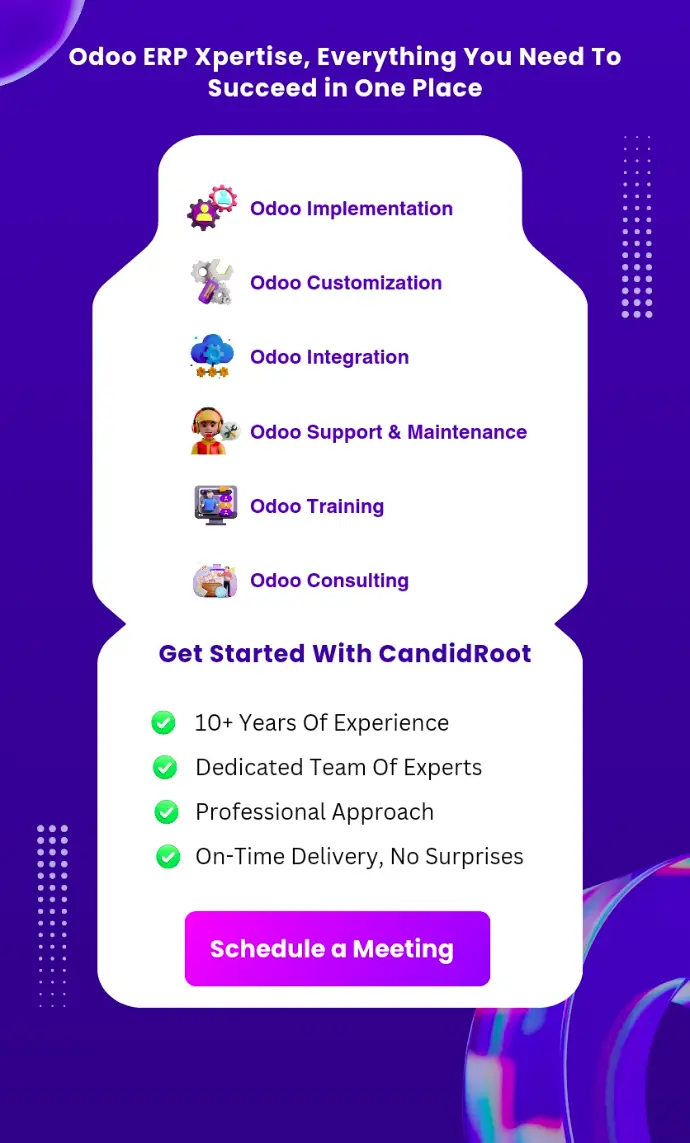Defining Requirements and Planning for Odoo ERP
The first step in developing an ERP system with Odoo is to define the specific requirements of your business. Identify the core functionalities and processes that need to be integrated into the system. This includes modules, workflows, reports, and any other features necessary for your business operations. Once the requirements are defined, create a comprehensive project plan that outlines the development timeline, resource allocation, and milestones.
Read More: What is Odoo ERP
Installation and Configuration
To begin the development process, you need to install and configure Odoo on your desired platform. Odoo supports both on-premises and cloud-based installations. Follow the installation guide provided by Odoo and ensure that the system is running smoothly. Customize the basic settings, such as company information, currencies, and languages, to align with your business needs.
Module Development
Odoo's modular structure allows you to develop and integrate custom modules based on your requirements. Start by analyzing the existing modules and determine if any can be used as a foundation for customization. If not, develop new modules from scratch. Odoo uses Python as its programming language, so having Python development skills is advantageous. Create the necessary models, views, and controllers within the module, and define the relationships and workflows between different entities.
User Interface Customization
A user-friendly and intuitive interface is crucial for user adoption and satisfaction. Customize the Odoo user interface to align with your brand identity and make it more user-friendly. Modify existing views or create new ones to display the information in a format that suits your business processes. Odoo provides a drag-and-drop editor that simplifies UI customization, allowing you to arrange fields, add custom buttons, and define access rights. Furthermore, Odoo's user interface customization capabilities extend beyond basic modifications. With the drag-and-drop editor, you can rearrange fields, create custom dashboards, and design personalized menus. This flexibility allows you to optimize the user experience based on your business requirements.
In addition to visual customization, Odoo allows you to define access rights for different user roles. By setting permissions and restrictions, you can ensure that users only have access to the relevant modules and data, maintaining data security and privacy.
Workflow and Automation
One of the key advantages of an ERP system is process automation—Utilize Odoo's workflow engine to automate routine tasks, approvals, and notifications. Define the sequential and parallel steps involved in each process, set conditions, and assign responsibilities. Automating processes improves efficiency, reduces errors, and enables better resource utilization. The workflow engine in Odoo allows you to map out your business processes and automate them with ease. By defining sequential and parallel steps, you can create a visual representation of your workflows, including all the necessary actions and decision points.
With the workflow engine, you can set conditions and triggers that determine when certain actions should be executed. For example, you can configure the system to automatically send notifications or reminders when a task is due or when a specific event occurs. This eliminates the need for manual follow-ups and ensures that everyone involved in the process stays informed and on track.
Data Migration and Integration
If you are transitioning from an existing system to Odoo, data migration is a critical step. Identify the data that needs to be migrated and develop scripts or use Odoo's built-in import tools to transfer the data seamlessly. Additionally, Odoo integration with other systems such as CRM, e-commerce platforms, or payment gateways to ensure smooth data flow and real-time synchronization. Alternatively, Odoo offers built-in import tools that facilitate data migration. These tools enable you to import data from various file formats, such as CSV or Excel, directly into Odoo's database. The import tools have mapping capabilities, allowing you to match fields from the source file with corresponding fields in Odoo. This simplifies the migration process, especially for non-technical users.
Testing and Quality Assurance
Thoroughly test the developed modules, workflows, and integrations to ensure that they function as expected. Conduct functional testing, performance testing, and user acceptance testing to identify any bugs or issues. Make necessary adjustments and refinements to enhance the system's stability, reliability, and usability.
Training and Deployment
Once the ERP system is thoroughly tested, it's time to train the end-users on how to effectively utilize Odoo. Conduct training sessions and provide comprehensive documentation to guide users through different processes and features. Develop user manuals, FAQs, and conduct workshops to address any queries or concerns. After the training phase, deploy the ERP system to your production environment and ensure a smooth transition from the old system to Odoo. Training and deployment are critical stages in the successful implementation of an Odoo ERP system. Through comprehensive Odoo training and support, you can empower end-users to leverage the full potential of Odoo's features. A smooth and well-planned deployment ensures a seamless transition from the previous system to Odoo, improving your organisation's efficiency and productivity.
Ongoing Support and Maintenance
ERP development is an ongoing process, and it's crucial to provide continuous support and maintenance. Regularly update Odoo to the latest version, monitor system performance, and address any issues promptly. Stay updated with Odoo's community and official documentation to leverage new features and enhancements. Ongoing support and maintenance are crucial for the continued success of your Odoo ERP system.
Regular updates, system monitoring, issue resolution, user training, and staying connected with the community ensure your ERP system remains secure, performant, and aligned with your business needs. By providing continuous Odoo support and embracing new enhancements, you can unlock the full potential of Odoo and drive sustainable business growth.
Conclusion
Developing an ERP system with Odoo offers businesses a comprehensive solution to streamline their operations, increase productivity, and better control various processes. By understanding the fundamentals of Odoo, defining requirements, customizing the user interface, automating workflows, integrating data, and conducting thorough testing, businesses can successfully develop an ERP system tailored to their specific needs.


